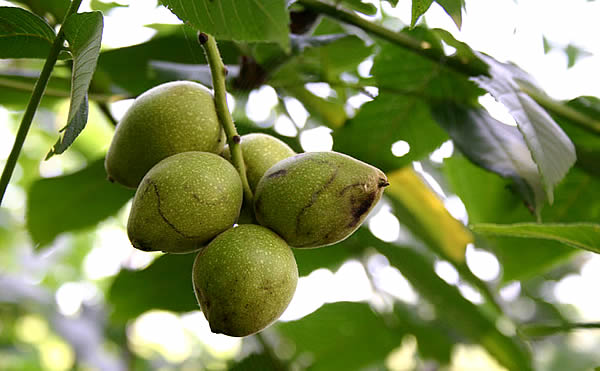The Manchurian nut belongs to the nut family and is considered to be the closest relative walnut. In addition to the attractive appearance, the culture has pronounced healing properties and is valued not only in various fields of medicine, but also in cosmetology, as well as in cooking.
In this article we will talk about the description of the Manchurian nut, its therapeutic benefits and harm to the body, as well as learn how to care for it in your summer cottage.
Table of contents
Characteristics and description of the Manchu nut
Manchurian walnut belongs to the genus walnut and is a shrub or deciduous tree type. Culture is considered monoecious, in other words, male and female inflorescences grow on the same tree. The second name of the plant is dumbay nut.
The native land of culture is considered to be northeastern China, and, more precisely, the region called Manchuria. It also grows in nature in the Korean Peninsula and the Far East, in particular, in the Amur region, Primorye, on Sakhalin.
Externally, the Manchurian nut is quite remarkable. The crown of the tree is different spreading and something like a ball. The color of the bark is closer to dark gray, but the tint of the shoots is more brown. In natural conditions, the height of adult culture can reach 30 m, and life expectancy is long - up to 200-250 years. In this case, the active growth of the tree lasts only up to 80-90 years, after which the process slows down.
The leaves of the Manchurian walnut are characterized by quite large sizes, unlike the closest relative - walnut. It is interesting that one leaf consists of 8-20 oblong and smaller leaves with jagged edges. On average, the total length is about 50 cm, but there are specimens with sizes reaching 100 cm. In the summer, the foliage has a rich emerald color, and by the autumn it acquires a golden hue.
At 10-12 years old, the plant begins to bear fruit. At the same time flowering occurs in April-May, but the harvest of fruits can be collected only at the end of summer - early autumn. As for the appearance, the shape of the nuts resembles an oval, and the size is about 3-5 cm in diameter. Grow in clusters of 2-7 fruits on a branch. It should be noted that the Manchurian nut shell is durable, and the thickness reaches 5 mm.
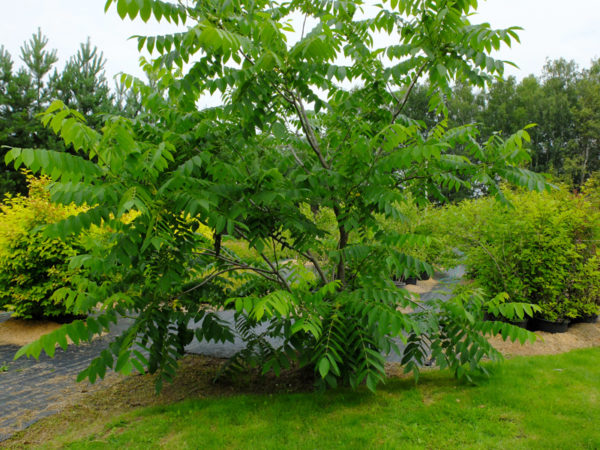
The benefits and harm to the body in Siberia
The Manchurian nut can be called a somewhat unique culture. Leaves, bark, and, of course, the fruits of the plant have amazing healing properties. Naturally, such opportunities are determined by the richness of the chemical composition, the main components of which are considered:
- vitamins of groups A, C, B;
- tannins;
- potassium;
- magnesium;
- carotene;
- phytoncides;
- alkaloids.
In addition, the walnut pericarp includes malic, gallic, citric acids, coumarins and vitamins of group P.
As for the beneficial properties, they distinguish the following plant abilities:
- antiseptic, wound healing properties;
- anti-inflammatory effect;
- analgesic effect;
- vasodilator effect;
- diuretic effect;
- an obstacle to the development of parasites in the body;
- air purification;
- antifungal properties;
- improvement of the gastrointestinal tract;
- antispasmodic effect.
The healing effect of the Manchurian nut has long been known and proven - the body's tone increases, the digestive tract is optimized, the appearance of the skin and hair is improved. But there are some contraindications to the use of funds based on it.The first is to highlight the pregnancy and lactation. And it is also strictly forbidden to take inside the funds on the basis of the plant for people suffering from liver cirrhosis, ulcers and gastritis.
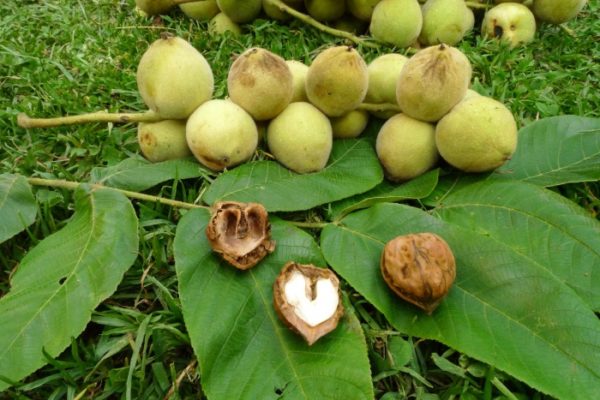
Medicinal properties and application of the fruit of the tree
The scope of the Manchurian nut is very wide. Of course, the most famous is the use in medicine tinctures and decoctions of plants. Here you can highlight the following areas:
- for the fastest tightening of wounds and other injuries on the skin;
- stopping bleeding;
- for skin diseases: eczema, lichen, rash;
- acne;
- blood pressure disorders;
- anemia;
- heart disease;
- the presence of parasites in the body;
- colds and infections;
- gastritis, diarrhea, constipation;
- diabetes;
- varicose veins;
- pyelonephritis;
- disorders of the thyroid gland;
- dandruff, brittleness, hair loss.
The most famous among lovers of traditional medicine are tinctures based on the Manchurian nut. They have a tonic effect on the body and normalize the work of all its systems.
Recipes of Manchurian Walnut Tinctures:
- On vodka. Grind 30-40 nuts and pour 1 liter of vodka. Add honey to taste. Insist in a dark place for 5 weeks. Take the tool should be 30 minutes before meals, but not less than 1 tbsp. l per day.
- On the water. Grind 1 tbsp. l leaves of the plant and pour 200 ml of boiling water. Insist 30 minutes, strain. Take orally 3 times a day.
Directly kernel nuts fashionable to eat. Also from the fruit is the oil used in culinary recipes. And from small unripened nuts they cook tasty jam.
A very interesting fact is that the wood of culture has high strength and extremely attractive texture. Due to this, Dombay nut is widely used in furniture production, and also used to create various souvenirs. Paint and wood semifinished products are successfully produced from the nut pericarp.
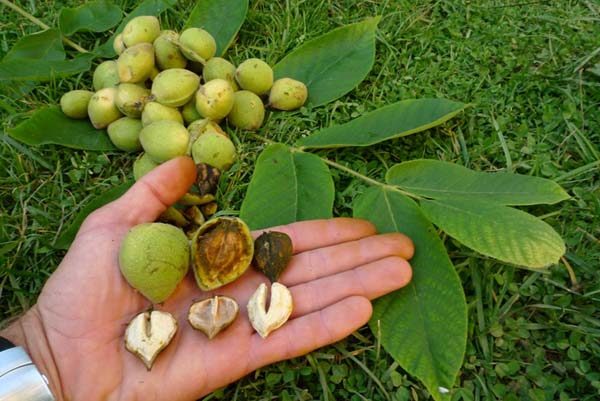
Rules of planting and growing in the Urals
Since the Manchurian nut is distinguished by unpretentiousness, it is realistic to plant and grow it in almost any conditions. In addition, designers often use it in landscape design. This can be done by planting seedlings or seeds.
Each growing method requires paying attention to 2 important points.
- The choice of location. Culture belongs to the light-loving plants, so the habitat must be open and sunny. And since the root system of the Manchurian nut grows deep and wide, you should choose a site away from buildings and other garden crops.
- The composition of the soil. The soil should be fertile, well drained.
With regard to the process of planting, here each method involves its own nuances.
Planting seedlings:
- Seedlings should be purchased in advance at a specialty store.
- If the soil is rather poor, a mixture of soil, humus, sod and sand should be prepared in a ratio of 4: 2: 2: 1.At the bottom of the pits lay out the drainage in the form of brick fragments or gravel, rubble.
- A part of the soil mixture is placed in a pre-prepared well, at least 80 cm in size. Potassium fertilizer is introduced or 1 cup of wood ash. The seedling is placed in the hole and immediately tied to the peg, and then powdered with planting mixture. After that, a bucket of water is poured into the hole and the remaining soil is poured. Further, the sapling again spills 0.5-1 liters of water.
Planting seeds is somewhat different from the cultivation of seedlings and suggests its own characteristics. It is worthwhile to clarify here that it is preferable to land at winter, in other words, in September. In this case, a preliminary stratification of seeds will not be required, and seedlings will appear much earlier.
There are the following stages of planting seeds:
- For planting should choose nuts collected no more than 3 years ago, since the third year, germination is significantly reduced.
- The soil for sowing should be fertile, drained. The site should be pre-dig and make 2-3 cups of wood ash. Then you need to form a bed and carefully shed it.
- Seed wells are prepared at least 8 cm apart. The depth of the pits should be 6-8 cm.
- Nuts are laid in the hole on the edge and sprinkled with earth.
- Shoots nuts can immediately move to a permanent place, but you should first pinch the taproot. It is not forbidden to leave the seedlings in place for another year, and then transplanted to the prepared area.
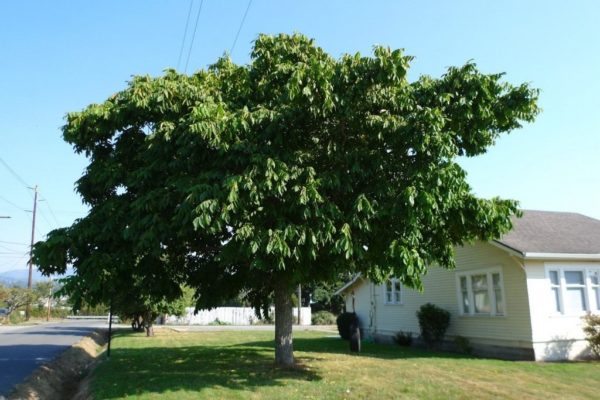
Rules of care in the suburbs
Immediately after planting the seedling or the fruit of the nut, the soil will need to be mulched with sawdust, peat, and healthy foliage. Of course, the bed should be carefully watered beforehand and subsequently also maintain humidity.
If the planting was done in the fall, before the cold young saplings will need to wrap with non-woven material and cover with a protective net from rodents.
Further care of the young plant includes the following points:
- Weekly watering plants. After 2-3 years, the frequency of irrigation should be reduced to 2 times a month. Since the third year, the walnut is watered 1 time in 30 days.
- Regular weeding, loosening and mulching the soil around the seedling to maintain moisture.
- In the second half of summer, the culture must be fertilized with fertilizer. Here, the best option is superphosphate. It will be necessary to dilute 20 g of the substance in 10 liters of water and water the soil around the plant with it.
- In order to avoid sunburn, the stem of the plant should be regularly whitened with a solution of lime with the addition of clay.
Diseases and pests
Manchurian nut is resistant to diseases. But there are exceptions.
It is possible to distinguish the following possible diseases of the nut:
- Fungal diseases. A sign here is the drying and blackening of the leaves. As a treatment, it will be necessary to spray the plant with Fundazole or another agent containing copper. The procedure is repeated after 2 weeks.
- Gall mite. Females lay eggs in the central part of the leaves, because of which they form characteristic tubercles. The plant should be treated with colloidal sulfur diluted in 10 liters of water at the time of bud break.From the beginning of summer, you can spray Fufanon every 10 days. Branches heavily damaged by ticks must be removed and burned.
- Nutcracker This insect infects the bark, leaves and buds of the nut. The best method of struggle is pruning damaged areas of the plant. But if adults emerged from the larvae, the plant should be treated with chlorophos (0.2%) or karbofos (90 g per 10 liters of water).
In general, the unique antimicrobial properties of the culture allow the plant to protect itself from the attacks of harmful organisms.
The healing properties, taste, and the attractive beauty of the Manchurian walnut make it increasingly necessary to pay attention to the unusual culture. And the ease of planting, as well as ease of further care, determine the popularity of plants among experienced gardeners and beginners.
